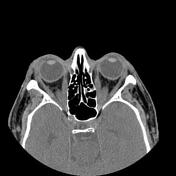Items tagged “ophthalmology”
41 results found
Article
Endophthalmitis
Endophthalmitis (plural: endophthalmitides) is a potentially sight-threatening condition that involves intraocular inflammation of any cause. It is distinguished from panophthalmitis in that it does not extend beyond the sclera. It is either infectious or non-infectious in etiology, but in clini...
Article
Adie pupil
Adie pupil (also known as tonic pupil) is caused by idiopathic degeneration of the ciliary ganglion, which sometimes occurs following a viral or bacterial illness. It is usually unilateral and typically affects young females 1.
Adie pupil represents a large dilated "tonic pupil", which does not...
Article
Brown syndrome (orbit)
Brown syndrome refers to a failure of upward gaze while the eye is adducted secondary to an abnormality of the superior oblique tendon sheath complex.
Pathology
This abnormality is a little counter-intuitive and highlights how the action of the superior oblique is position-dependent and that e...
Article
Senile calcific scleral plaques
Senile calcific scleral plaques, also known as senile scleral plaques, are benign degenerations of the ocular sclerae, common in elderly individuals. They are a common incidental finding on CT.
Epidemiology
The prevalence of senile scleral plaques increases with age, from ~2.5% at age 60, to 2...
Article
Scleromalacia perforans
Scleromalacia perforans, or non-inflammatory necrotizing scleritis, is a severe and very rare form of scleritis.
Epidemiology
Associations
rheumatoid arthritis
Crohn disease
ulcerative colitis
systemic lupus erythematosus
Behçet disease 5
relapsing polychondritis 5
granulomatosis with p...
Article
Trochlear nerve palsy
Trochlear nerve palsies, or fourth nerve palsies, result in weakness of the superior oblique muscle.
Clinical presentation
Vertical diplopia and ipsilateral hypertropia in the absence of ptosis, combined with a head tilt away from the affected side, are strongly suggestive of trochlear nerve p...
Article
Choroidal hemangioma
Choroidal hemangiomas are benign vascular hamartomatous tumors of the choroid. They present in two forms based on the extent of choroidal involvement:
circumscribed choroidal hemangioma (CCH): solitary tumor with no systemic associations.
diffuse choroidal hemangioma (DCH): usually in associat...
Article
Retina
The retina (plural: retinas/retinae) forms part of the optic pathway. It is a thin lining on the inner surface of the globe and converts visible light into a neural signal.
Arterial supply
The blood supply of the retina is from two sources, supplying different portions of the organ. The integ...
Article
Sclera
The sclera (plural: scleras or sclerae) is the fibrous, opaque white, coat of the eye. It functions to protect the intraocular contents.
Summary
location: posterior fifth-sixths of the eyeball
blood supply: ciliary arteries
innervation: ciliary nerves
relations: anteriorly continuous with ...
Article
Orbital compartment syndrome
Orbital compartment syndrome is an ophthalmological emergency referring to an increased intraorbital pressure that may lead to permanent visual impairment if left untreated.
Clinical presentation
Findings on exam may include:
decreased visual acuity 6
globe palpably tense and resistant to ma...
Article
Lenticonus
Lenticonus is a rare congenital abnormality characterized by conical bulging of the posterior or anterior lens surface. If the bulging is global rather than conical, the condition is referred to as lentiglobus 1.
Clinical presentation
It produces a decrease in visual acuity and irregular refra...
Article
Choroid (eye)
The choroid is part of the uveal layer of the eye along with the ciliary body and iris 1.
Summary
location: posterior aspect of the globe
function: vascularization of the outer retina
arterial supply: posterior ciliary arteries
innervation: short ciliary nerves, long ciliary nerves
relat...
Article
Nasolacrimal injury
Nasolacrimal injuries are reported to be common and may result in temporary or permanent dysfunction.
Epidemiology
Fracture of the nasolacrimal apparatus has been reported in ~10% of patients with craniofacial fracture, with ~10% of these reporting symptoms of epiphora or dacryocystitis 1.
...
Article
Central retinal vein occlusion
A leading cause of monocular vision loss, central retinal vein occlusion (CRVO) is most commonly caused by thrombosis of the central retinal vein, resulting in retinal edema and hemorrhage.
Terminology
Occlusion of the central retinal vein is subclassified as ischemic and non-ischemic based on...
Article
Hollenhorst plaque
Hollenhorst plaques are seen on clinical examination of the retina and are the result of cholesterol emboli at the retinal arteriole bifrication 1. They most commonly originate from the carotid or aortic atheroscleroritc plaque 2. Hollenhorst plaques are a a risk factor for ischemic stroke and a...
Article
Dacryops
Dacryops, also known as lacrimal gland or duct cyst, is a rare phenomenon where a retention cyst is formed within the lacrimal gland due to duct obstruction.
Epidemiology
Dacryops is an uncommon benign orbital lesion with an incidence of 0.5-2% 1. It usually affects young adults or middle-aged...
Case
Brown syndrome

Published
31 Aug 2021
77% complete
MRI
Case
Thyroid eye disease

Published
08 Mar 2022
100% complete
CT
Case
Coloboma of the optic nerve head

Published
05 Sep 2022
94% complete
Ultrasound
Article
Hypermetropia
Hypermetropia, also known as long-sightedness or hyperopia, is a refractive disorder. Though it can happen in any age group, it usually starts from mid-late adulthood.
Clinical presentation
In this condition, distant objects are seen better than close objects.
Pathology
The blurriness of nea...







 Unable to process the form. Check for errors and try again.
Unable to process the form. Check for errors and try again.